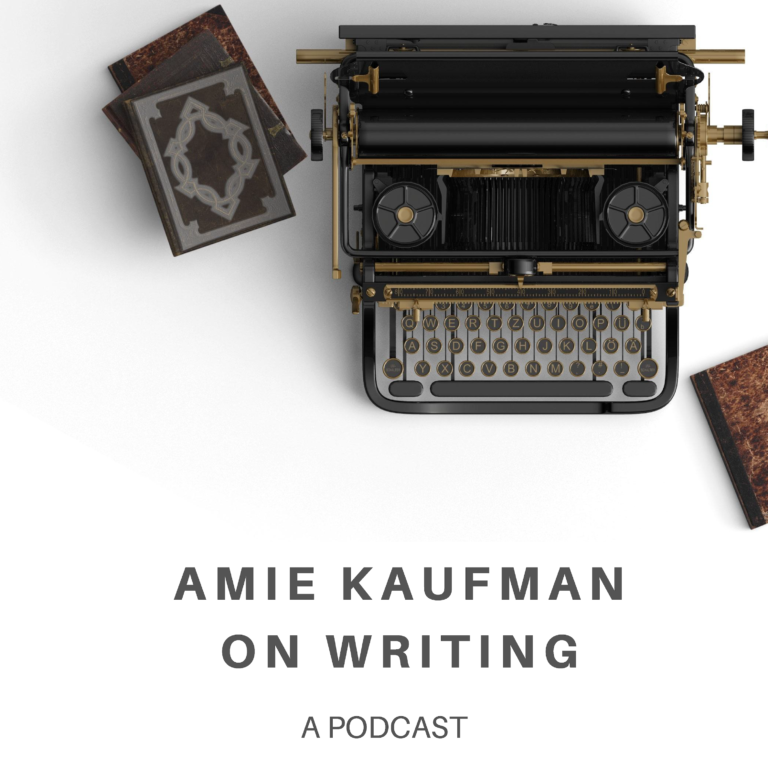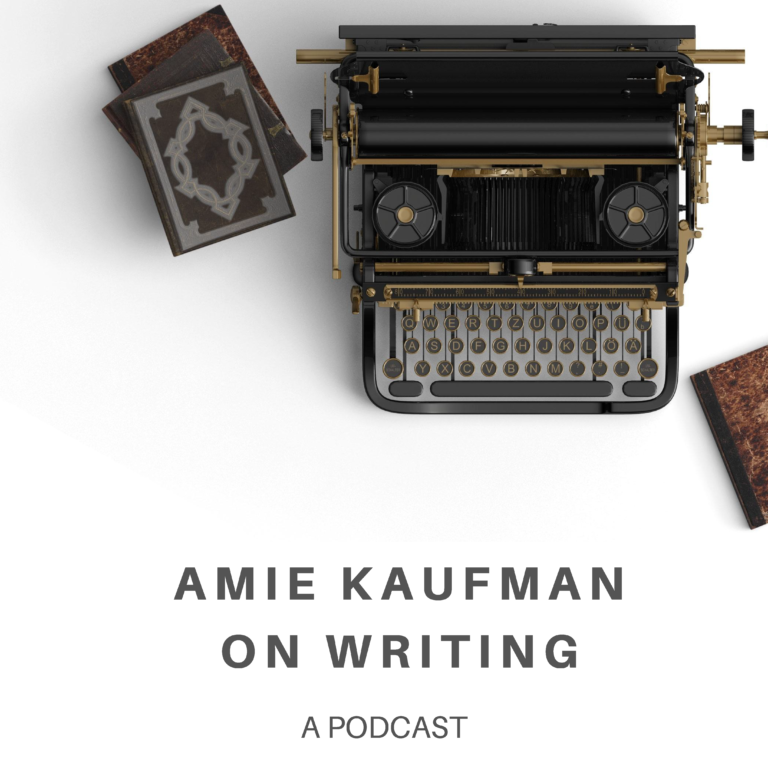Episode 7: Four Tips on Backstory Without Info Dumps

New York Times and internationally bestselling author Amie Kaufman answers one question each week about writing craft. Full of practical tips and an exercise each week, this is a show for writers, for readers who want a backstage look at how their favourite authors craft their stories, or for creative writing classrooms.
You can find a transcript of this episode at my website, where you can also subscribe to my newsletter, get behind-the-scenes peeks at how I write, and any other news about new books, events or the podcast. You can also submit a question for the podcast on my website. You can find me on Twitter or Instagram.

FOLLOW ON APPLE PODCASTS . FOLLOW ON SPOTIFY . FOLLOW ON OVERCAST . FOLLOW ON PODCAST ADDICT
Season 2, Episode 7: Four Tips on Backstory Without Info Dumps
Hi, my friends.
Welcome to Amie Kaufman on Writing, a short podcast that answers one question each week about how writers do what they do.
If you’re a writer, or you’re a reader interested in how your favourite authors craft their stories, then you’re in the right place.
This is Season 2, Episode 7: Backstory Without Info Dumps.
Here’s my friend and producer Kate with this week’s question. Hi Kate, how are you?
Hi Amie, I’m good!
This week’s question is from Jaclyn, who says: How do I weave in backstory so it doesn’t disrupt the flow of the narrative, or feel like an info dump?
Jaclyn, you’re on the right track, just knowing this is an issue. We all know the feeling of reading and enjoying a story, only to find it suddenly screeching to a halt so we can enjoy a quick lecture on the protagonist’s backstory, or the history of the world.
We don’t want the reader to have to wade through all this information and get bored—but we also know that backstory is one of the reasons the reader will care about our characters. It helps them understand the characters’ motivations, care about what’s at stake, and gasp at the significance of all the twists and turns and reveals.
So, how do we share backstory without devolving into one giant info-dump?
Here are four tips:
Tip one – write it all out. This tip is designed to avoid either the urge to tell the reader everything—because you truly believe it’s all important, or because you spent so much time on it. It’s also designed to combat the habit many writers have of figuring out their backstory by writing it into the story in giant clumps.
What do you do instead? Imagine that you’re allowed to give your reader a briefing. You can tell them whatever you like, to help them understand the story. Write it all up in a document that’s a page or two or three long. Then set that document aside, and write the story as though they’ve read your whole briefing from start to finish. You don’t need to share what’s in it, because you already covered it.
Now, when you get to the end of the draft, it may be that a few things from the briefing need to go into the book – and the next tips will cover how to do that. But I’ll bet you that most of it can stay right where it is.
Tip two: Be tantalizing. Intrigue your reader, but don’t tell them too much all at once. Instead, leave a trail of breadcrumbs – or chocolate crumbs, that sounds more tempting – that they simply can’t help following.
Is your character an orphan? No need to give us the whole story on how their parents died up front. No need to even say they’re dead. Just have your character living with a guardian—or referring to one, if they’re an adult—and let the reader wonder for a little.
Or let’s take an example from my book Unearthed, which I wrote with Meagan Spooner. It’s a sort of ‘Indiana Jones teams up with Lara Croft, on an alien planet’ story. Our scavenger, Mia, is on an incredibly risky and illegal mission to the planet Gaia because she needs the money. Badly. Why is that? Well . . . you’ll have to wait a little to find out. And even when you find out who it’s for, you’ll have to wait again to find out what kind of danger that person is in. You’ll be tugged along by this and lots of other mysteries about how the characters came to be where they are, and as an added bonus, by the time you learn about the stakes for them, and the people they love, you’ll care too—because you care about our characters.
Here’s tip three: Only reveal information when there’s a prompt in the story to do so. If you want to tell us how important it is that a character grew up cooking with her grandmother, then have her see the dish on a menu.
Or take, say, The World Between Blinks, which I wrote with Ryan Graudin. It’s a story about two cousins who go on an incredible adventure, and it all begins at their grandmother’s house. She passed away the year before, and it’s the last time the family is getting together there before it’s sold. Rather than telling the reader all this up front, before they’ve learned to care, Ryan and I waited until the cousins arrived at their Nana’s house. Then, as they moved through it, their memories were prompted by the things they saw.
There are a thousand ways to do it, but tying backstory and memories to moments in the text mimics the way we think about things in real life. Drive past the house where you lived as a kid, of course you’ll think back on those times. Ask yourself what could prompt your characters.
Here’s the fourth and final tip: Have a character to hand who doesn’t know about this stuff. Rather than having characters tell each other things they already know—I talked about this kind of info-dumping in season one, episode three, when we discussed the dreaded “As you know, Bob” infodump, where one character tells another character something they… you guessed it, already know.
In Aurora Rising, Jay and I had this in mind when we created the character of Aurora O’Malley. She’s just woken up after two centuries in stasis. While she was asleep, humanity has explored the universe, met aliens, and unbeknownst to most of the species, got itself into a mess that Aurora’s about to help fix. She has about a thousand questions, and it’s natural for her to ask them when something happens that prompts her curiosity.
So there you have it – four tips for weaving in backstory:
- One, write a briefing note for your reader, then set it aside.
- Two, dole your backstory our sparingly, and temptingly.
- Three, reveal information when there’s a prompt in the story to do it.
- Four, have a character who can ask questions, becaue they don’t know this stuff.
Here’s an exercise: Re-read the first chapter of one of your favourite books. Spot the places where the author is sharing backstory with you—there’ll probably be fewer than you think, that early on—and think about the techniques they’re using to do it.
That’s all for this week. Next week, I’ll be answering a question about what to do when you fall out of love with your story.
In the meantime, I’ll remind you to subscribe, and leave the podcast a review wherever you listen. Both these things help new listeners find the podcast, and I really appreciate it.
You can find me at my website, which is at amiekaufman.com – you can subscribe to my newsletter there, for behind-the-scenes peeks at how I write, and any other news about new books, events or the podcast. You can also submit a question for the podcast on my website. You can find me on Instagram at @AmieKaufmanAuthor or on Twitter at @AmieKaufman. This podcast is produced by the lovely Kate Armstrong, host of one of my favourite podcasts, The Exploress, which time travels through women’s history one era at a time. You can find her at theexploresspodcast.com.
For now, thanks so much for listening – enjoy your reading, and enjoy your writing.
Have a Question?
You can submit your question using the form using the form on the main podcast page — if you’re stuck on one aspect of your work, or you’re wondering how your favourite author pulled something off, we’d love to hear from you!
